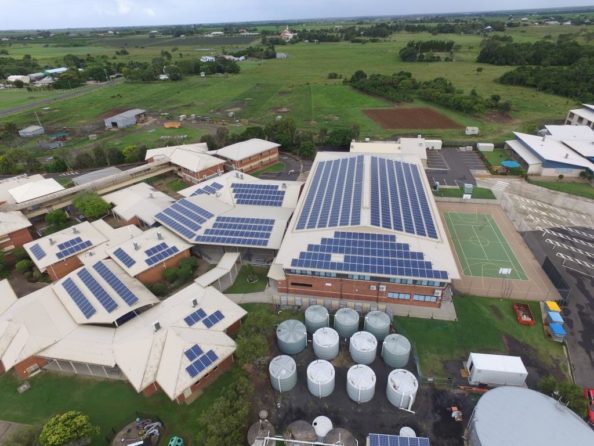
As the Greens’ latest renewable energy policy plank underscored this week, schools and solar PV make a great pairing. Add storage and it can get even better.
A great recent example of this can be found at Bundaberg Christian College. Located in Queensland’s top solar postcode, the college – which already harvests and treats all of its own water and sewerage – takes sustainability seriously. Harvesting its own electricity was the next logical step.
For this, the College turned to local outfit GEM Energy, who along with Melbourne-based inverter maker and energy management specialist Selectronic, designed and installed a big enough solar and battery storage system to drastically reduce the College’s reliance on grid supplied electricity.
The result, pictured below, was a 194kW solar system with 250kWh of battery storage (located in the white container to the right of the water tanks), completed and switched on in March, which claims to be the largest hybrid solar and storage array ever to be installed at an Australian school.

As One Step readers would know, this is not the largest solar array ever installed on a school. The honours for that achievement will go to Canberra’s Amaroo School, which last year commissioned a 600kW rooftop PV system; currently, they are claimed by Mazenod College in Melbourne, which installed a 270kW PV array in 2014.
But the Bundaberg Christian College’s 194kW solar system would certainly be the largest, and perhaps the only, school-based system to be paired with battery storage; or to be built in conjunction with – and without hampering – a rooftop water harvesting system.
The 700-panel solar array was also designed to factor in the switching of the school’s lighting from fluorescent to LED, thus reducing its total size and cost. Even the used fluoro lights did not go to waste, but were donated to a school in Vanuatu that had suffered damage due to Cyclone Pam.
The control and battery component of the project is housed in an onsite 20-foot storage container (pictured above) consisting of a three-phase SP PRO system and the 250kWh battery bank, which is made up of 30 Hitachi lead acid batteries (both pictured below).


These store excess electricity generated by the panels during daylight hours to supply overnight demand, including for security lighting and computer servers.
Annually, the system is expected to save the school up to $100,000 by cutting its use of grid electricity by as much as 80 per cent. With these savings, the system is expected to pay for itself in seven years.
“In anyone’s terms, that’s a good deal,” said the College’s business manager, Evan Keune, in an interview with the ABC.
“Once the solar really kicks in around 10 o’clock, we’re using minimal power til about two in the afternoon,” he said.
“A lot of schools have small solar systems from government grants, but they’re only 30 or 40 kilowatt systems, whereas ours is 170 plus batteries,” he said.
“With the viability of solar and batteries, this is now coming into play as an option for a lot of schools and a lot of businesses.
“We’ve already had a couple of schools contact us because they’ve heard what we’re doing and they’re quite interested.”

Sophie is editor of One Step Off The Grid and deputy editor of its sister site, Renew Economy. Sophie has been writing about clean energy for more than a decade.


